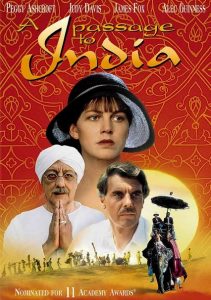A Passage to India-1984
Director David Lean
Starring Judy Davis, Peggy Ashcroft
Scott’s Review #971
Reviewed December 24, 2019
Grade: A-
David Lean, famous for his sweeping, masterpiece epics including Lawrence of Arabia (1962) and Doctor Zhivago (1965), returns with his swan song, a grandiose and lavish film, A Passage to India (1984).
Though not quite on the same level as the two other mentions, the brilliant cinematography alone makes this one a winner.
The story is compelling with a mystery and he said/she said rape story that deepens, exploring racism and religion, assuredly switching viewer allegiances between characters.
A Passage to India is based on the famous E.M. Forster novel from 1924. Along with A Room with a View (1908) and Howards End (1910), the three make up a series that examines class differences and hypocrisy among the British.
All three are set at least partially in England and were all adapted to film with immeasurable success. While the film is potent and meaningful, it is the least brilliant of the three, but only by a hair.
Set in the 1920s, the British had control over India causing some tensions in the air. Adela Quested (Judy Davis) sails from England to India with Mrs. Moore (Peggy Ashcroft), the mother of her intended bridegroom, whom they plan to see when they arrive at their destination.
The women have a wonderful relationship and excitedly anticipate their adventure.
After Mrs. Moore meets the kindly Dr. Aziz Ahmed (Victor Banerjee), becoming enamored and enraptured, the women accompany him to an exploration of ancient caves, along with a guide.
When Adela and Ahmed are left alone, she suddenly appears frantic, accusing the Indian Doctor of attempted rape, setting off a blistering scandal that causes public debate and divides the townspeople, culminating in a trial.
The story is naturally the focal point of the film, but not the strongest part. At first left aghast at the accusations hurled at Aziz, by all appearances a wonderful man, the intention is for the viewer to be unclear of what transpires when Aziz and Adela are alone. The events, if any exist, take place off-screen, so we only see a disheveled Adela flee the caves in panic.
The rest is left to the viewer’s imagination and to wonder what happened. As the truth is eventually revealed, we wonder about the intended motivations and the ramifications the accusations will have on the central characters.
The film is successful at interestingly discussing racism and assumptions, leading major characters to disagree. Adela and Mrs. Moore wind up at odds after the events, with Moore refusing to believe Aziz did anything wrong.
This is a bold stance to take as the women are good friends and we would assume one would support the other. While Moore is liberal and open-minded, Adela is conservative and buttoned-up, making the ideological differences clearer.
Did Adela imagine the attack? Did somebody else attack her?
The cinematography is brilliant and the pure excellence of the film is. The plentiful exterior scenes are delectable and simmer with beauty within each frame. Since many of them take place in the grandiose mountains or caves the results are exquisite.
One can easily sit back and revel in the majestic sequences and many scenes are still and quiet which enhances the effects. As with other Lean epics, it advisable is to see this film on the biggest screen known to mankind.
At one-hundred and sixty-four minutes, the film is hardly non-stop action, but rather slightly laborious and lumbering. Some parts are a tad too slow, but the payoff is mighty and there is a measure of intrigue throughout, especially once the cave incident occurs.
I hate to say the film drags, but perhaps fifteen to twenty minutes could have been shaved off. When Lean is at the helm, a hefty running time is a guarantee.
A Passage to India (1984) is a film by a respected director that culminates a lengthy and inspired career boldly. While not his best film, this should not detract from the excellent experience the film provides.
Grandiose sequences and sophisticated style make the film able to be viewed more than once, a marvel for a film released in the lackluster 1980s.
Oscar Nominations: 2 wins-Best Picture, Best Director-David Lean, Best Actress-Judy Davis, Best Supporting Actress-Peggy Ashcroft (won), Best Screenplay Based on Material from Another Medium, Best Original Score (won), Best Sound, Best Art Direction, Best Costume Design, Best Cinematography, Best Film Editing
